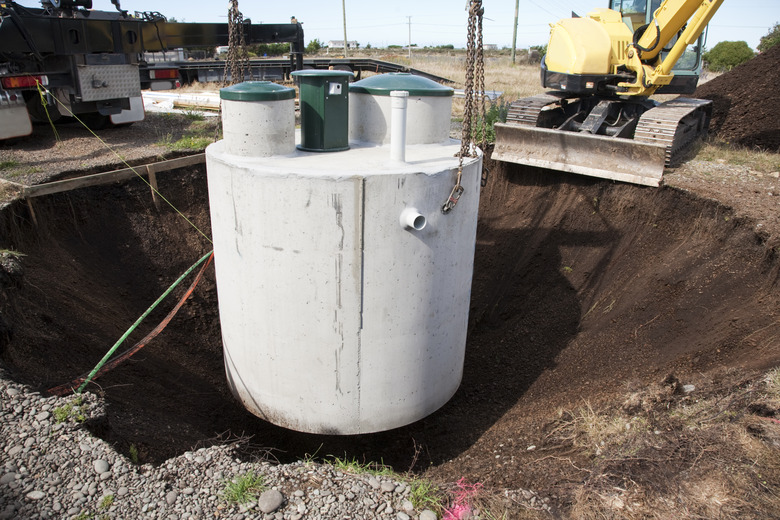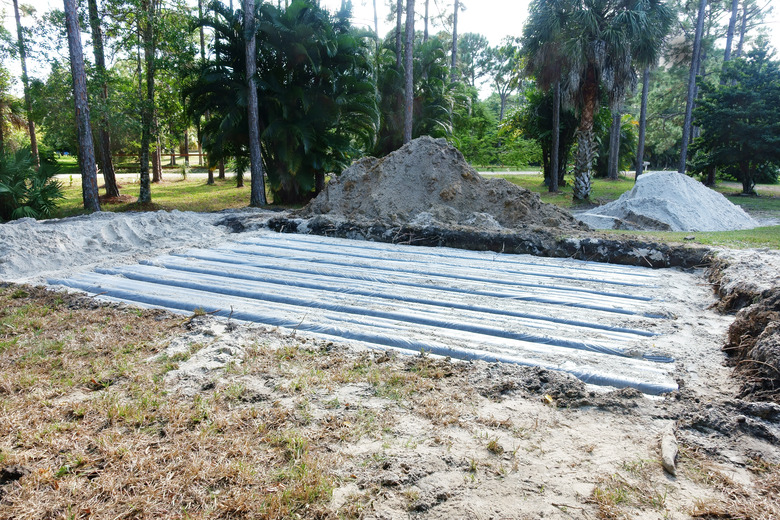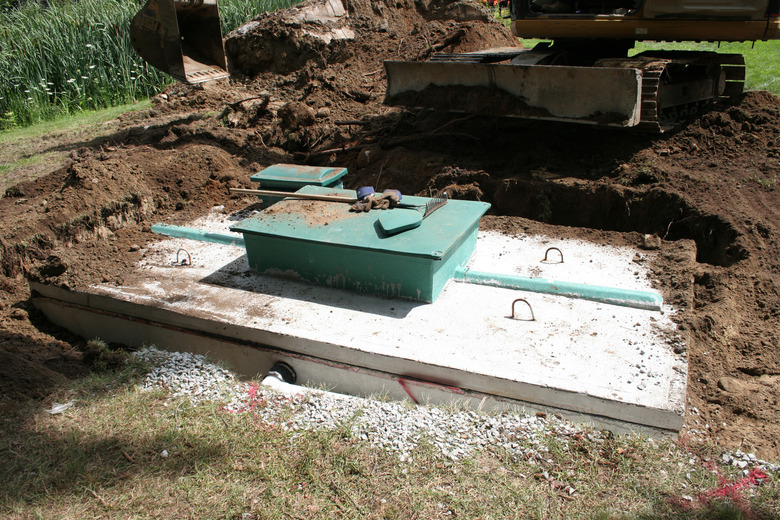Buying A Home With A Septic System? Here's Everything You Need To Know
Purchasing a home in a rural area too far from town to connect to a municipal waste system means inheriting a septic system. Unlike municipal sewer systems, a septic system is a living, breathing part of your property, and it's something with which you should become intimately familiar. If you neglect it, misunderstand how it works, or treat it poorly, you could find yourself in the midst of an expensive sanitation nightmare.
Most people know how a conventional septic system works, but the one that serves your new house may not be conventional and may require more maintenance. The type of system you're about to inherit depends on the lay of the land as well as what's underneath the surface of the ground. It may incorporate a pump or some other electrical equipment, and it may be more or less likely to clog depending on the soil characteristics and how it's designed.
You should have the septic system inspected as part of the home purchase process to ensure it's in good working order, but a green light from the inspector doesn't mean you can forget about it. Depending on the type, you may need to be on the lookout for warning signs of impending problems. You should use the system properly to minimize chances of these signs ever occurring, and that may call for some changes in your daily habits.
Every Septic System Has a Tank
Every Septic System Has a Tank
One of the first things the septic inspector will investigate is the condition of the septic tank, which is a large holding tank for waste from the home's plumbing system. The tank is typically located 10 to 20 feet from the house, and it's buried, so when the inspector uncovers it, you should note its location and plan for some landscaping best practices to protect it. For starters, you'll need to remove any trees growing within 20 feet of the tank to prevent root damage.
The manhole cover must always be accessible, so if you're planning to install a patio or decking, you'll have to build around the tank. Turf is the best covering because you can cut it away and replace it when you need to pump the tank or access it for another reason. To help you remember where it is, you might place a movable landscape feature over it, such as a birdbath.
The allowable materials for septic tanks are fiberglass, polyethylene, and concrete. If you're purchasing an older home with a metal or wood septic tank, you're going to have to replace it, so you should note that expense in your negotiations with the seller. You'll also have to replace a concrete tank that is cracked and leaking. One more thing to remember is that the septic tank is sized for the number of bathrooms, so if you're planning additions to the house, you might have to install a bigger tank.
From the Tank to the Drain Field
From the Tank to the Drain Field
In a typical septic system, wastewater enters the septic tank through an inlet, and with the aid of a partial barrier that slows flow, called a baffle, solids separate and fall to the bottom of the tank, while liquids remain on top. In a gravity-fed system, liquid discharges through an outlet port on the opposite side of the tank to a drain field. The drain field is also known as an absorption field because it absorbs pollutants and decontaminates the water through natural soil percolation.
Multiple variations have been developed to deal with poor soil conditions, lack of space, and elevation issues. For example, if the tank is at a lower elevation than the drain field, the system has to include a lift pump, which may be in the septic tank or in a separate chamber on the outflow side of the tank. If you purchase a home with a system that includes a lift pump, you need to remember that it's a crucial piece of equipment that needs maintenance.
The drain field in most gravity-fed systems is fed a system of perforated pipes that all connect to a central distribution center called a distribution box, which has a removable cover. When soil conditions are poor, it may be necessary to build a mound, or the perforated pipe may be replaced by drip tubing. In such instances, the distribution box is usually sealed and houses a pressure pump to force water into the drain field. This pump also requires maintenance.
Planning for Maintenance
Planning for Maintenance
Before you move into a new house, it's customary for the previous owner to have the tank pumped, and with regular use, you're going to have to do this again at three- to five-year intervals. The cost depends on who does the pumping, but it typically costs $350 to $600. The contractor who does the pumping will inspect the tank and alert you to any problems that you need to address, such as cracks in the tank or broken baffles. If the system has a lift pump or pressure pump, the contractor will also inspect those and alert you to any issues that need attention.
By and large, the drain field doesn't need much maintenance, but you need to keep an eye on what's growing out there. The roots of trees and large bushes can infiltrate the drain pipes and cause a clog, so if you see any growing within 20 feet of the leach field, you need to remove them. You also need to protect the leach field from vehicular traffic, and of course, you can't build anything directly on top of it. If you see an accumulation of surface water on the leach field during periods of heavy rain, you might have to install a drainage system to divert water away.
Proper Use of a Septic System
Proper Use of a Septic System
Most septic systems are anaerobic, which means they process waste without oxygen, and they are mostly trouble-free when you follow basic usage guidelines:
- Flush only bodily waste in the toilet — no household chemicals, no food waste, no diapers, and no paper products other than toilet paper, including paper towels.
- Do not use a garbage disposal because ground-up food waste upsets the ecological balance inside the tank. Compost your food waste instead.
- Avoid pouring oil and grease into the drain. They remain on the surface and travel straight to the leach field with the tank effluent. Once there, they congeal in the ground, making it less absorbent and shortening the life of the leach field. Coffee grounds, cigarette butts, paper items, flour, and similar contaminants can have the same effect.
- Limit your water use. Turn off faucets when you're soaping up in the shower or washing dishes. Take shorter showers and be sure the house is equipped with leak-free, low-flow toilets. The less water that goes into the septic system, the less water the drain field has to handle. Be especially vigilant during periods of heavy rain, when the drain field may be saturated.
- Don't use septic system cleaning additives. The Environmental Protection Agency has studied these and concluded that they don't work. A septic system works best when it only has to digest waste from the human body.
- Use septic-safe drain-cleaning chemicals. Caustic drain cleaners are bad for the tank and the drain field.
- Use phosphate-free laundry soap and dish soap. When phosphates enter the groundwater and flow into rivers and lakes, they cause harmful algae blooms.
Dealing With Septic System Backups
Dealing With Septic System Backups
Septic systems can and do experience backups, and the result can be overflowing floor drains or ground-floor toilets and drains. The most likely reason is that the tank is full, and the solution is to have the tank pumped. However, there are a number of other reasons for backups, some serious and others not so much.
If your system utilizes a pump, the pump may have stopped working. The reason might be a tripped circuit breaker, but it's also possible that the pump float mechanism or the pump itself is malfunctioning. This isn't a problem you can fix yourself, especially if the pump is located inside the tank, and you'll need to call for service. Never open the tank and try to find the problem yourself; the gases in the tank are highly toxic and can kill you.
Clogs in the drain field pipes or in the drain field itself can also cause backups. If a backup occurs in the winter, it could be because the wastewater in the pipes or the soil in the drain field has frozen, and in this case, there's little you can do but wait for warmer temperatures before resuming use of the toilets and drains. A drain field clog in warm weather is potentially a more serious problem because it could mean the ground is saturated and can't handle any more wastewater. That means you need to establish a new drain field, which is a big deal, and you'll wish you had been more careful about what you have been putting in the drains.
Get All the Details
Get All the Details
Sewage treatment in rural areas is subject to local health authorities, and they may mandate a particular type of system, such as an aerobic one, to minimize contamination of local waterways. If so, you need to know the details of that system before you purchase the house and commit to maintaining the tank, the oxygen pump, and all the related equipment. The tank for some treatment systems needs more frequent pumping than for others, and there may be stricter usage guidelines and maintenance protocols than there are for a conventional system.
For example, if you inherit a septic system that uses drip tubing in the leach field because of poor soil conditions, you'll have to be extra careful about how you use the plumbing. Even the smallest amount of grease or oil in the effluent water can clog drip tubing, and although it's easier to replace than perforated pipe, it's still an extra hassle. The same can be said of sand filter systems that many authorities require for drain fields close to bodies of water. Contaminants build up in the sand, and it has to be replaced periodically.
The septic inspector won't tell you everything you need to know about the system you're inheriting, so be sure to get full disclosure from the seller. That way, you'll be prepared for problems when they arise, and because you know what expenses might be involved, you won't be as shocked when problems occur.


